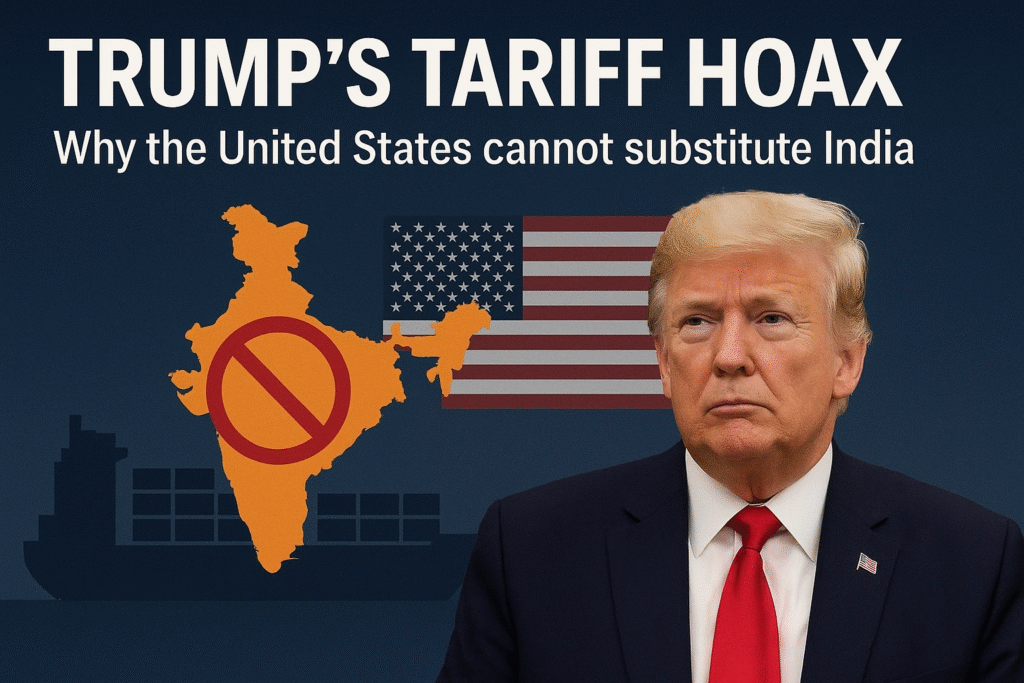
Trump’s tariff hoax – Why the United States cannot substitute India
Despite recent headline-making tariff threats, from 25% up to 50% on select goods, India’s economic ties with the U.S. are structured in a way that limits any potentially massive fallout. Here’s a breakdown fortified by hard data:
1. The impact of India-US trade on the Indian economy is Modest
According to the Indian government Data, India’s merchandise exports to the U.S. reached $86.5 billion, a 11.6% increase from the previous year. The U.S. remains India’s top trading partner, with a bilateral trade of $131.84 billion. Imports from the U.S. were $45.33 billion, with crude oil, petroleum products, and coal being major items. This amounts to roughly 2.2% of India’s GDP and 17% of its total exports, a significant but not dominant economic driver. India is not an export-driven economy.
2. Indian economic growth is driven by domestic consumption and not exports
Indian economic growth is driven by internal consumption. Private Final Consumption Expenditure (PFCE) or household spending contributes around 55–60% of India’s GDP (World Bank, IMF, RBI data). By contrast, exports of goods & services contribute only about 20% of GDP. This is very different from countries like China, South Korea, or Vietnam, where exports form 30–40%+ of GDP.
3. The Indian economy is resilient against external shocks
With 1.4 billion people, India has a vast consumer base. Rising middle-class incomes and urbanisation drive demand for FMCG, housing, transport, telecom, and services. Sectors like banking, e-commerce, automobiles, IT-enabled services, and healthcare are heavily dependent on domestic demand. Since domestic demand is the main engine, India is less vulnerable to global trade slowdowns compared to export-heavy economies. Example: Even during the 2008 global financial crisis and the 2020 pandemic, India’s economy experienced temporary slowdowns but didn’t collapse because internal consumption cushioned any decline in exports.
4. Limited Impact from Tariff Exposure
Per the Indian Council for Research on International Economic Relations (ICRIER), 70% of India’s goods exports to the U.S. (about $60.85 billion) are subject to U.S. tariffs—but this only equals 1.56% of India’s GDP and 7.38% of total exports
Another estimate, by the PHD Chamber of Commerce and Industry, predicts a max hit of 1.87% on India’s total merchandise exports and a mere 0.19% impact on GDP from a 25% U.S. tariff
5. Diversified & Tariff-Resilient Export Mix
India’s major exports to the US are pharmaceuticals, electronics, gems, and jewellery. The US government has exempted or insulated critical sectors, such as pharmaceuticals ($13B in U.S. imports, with India hosting over 262 FDA-compliant plants) and electronics/smartphones, which U.S. firms are actively manufacturing in India. India is currently the largest exporter of iPhones to the US. In the Gems & Jewellery sector, India accounts for 44.5% of U.S. imports. 90% of the world’s diamonds are cut and polished in India. Diamond cutting is artisanal work and has been done in India by artisan families for millennia. By comparison, the first discovery of diamonds outside India only happened in the 19th century. In other words, irrespective of whether Trump puts 50%, 100% or 1000% tariff, cut diamonds that go on American engagement rings are going to come from almost exclusively India.
India supplies over 60% of U.S. imports in niche categories like cumin, lab-grown diamonds, carpets, and table linen segments with high dependency and limited alternatives. India accounts for 70% of the world’s spice production. India is also the world’s largest rice producer. In other words, US importers have almost no alternative but to import these goods from India. As a result, importers will have no choice but to pay the tariff costs themselves and then pass on the additional cost to the American consumer. The tariffs will have minimal impact on Indian companies.
6. Geopolitical & Strategic Anchors Keep Pressure In Check
India–U.S. relations are as strategic as they are economic. Ministries and industry insiders point to the importance of maintaining stable trade ties amid global realignments—limiting how punitive tariff policies can become without broader repercussions.
7. Historical Evidence Confirms Resilience
When the U.S. ended India’s GSP status in 2019, affecting exports worth $6 billion, the actual drop in trade was minimal. A 2% average decline in affected products was observed, not a broad economic shock (Press Information Bureau, Institute of Development Studies).
Conclusion
While tariff hikes may dent earnings in sectors like textiles, and auto parts, their broader impact remains contained. India’s export base to the U.S. is diversified, includes many segments that either cannot be taxed or will not be impacted by tariffs, and constitutes only a small slice of GDP. Strategic imperatives and historical precedent suggest both nations have strong incentives to avoid disruptive economic paths.